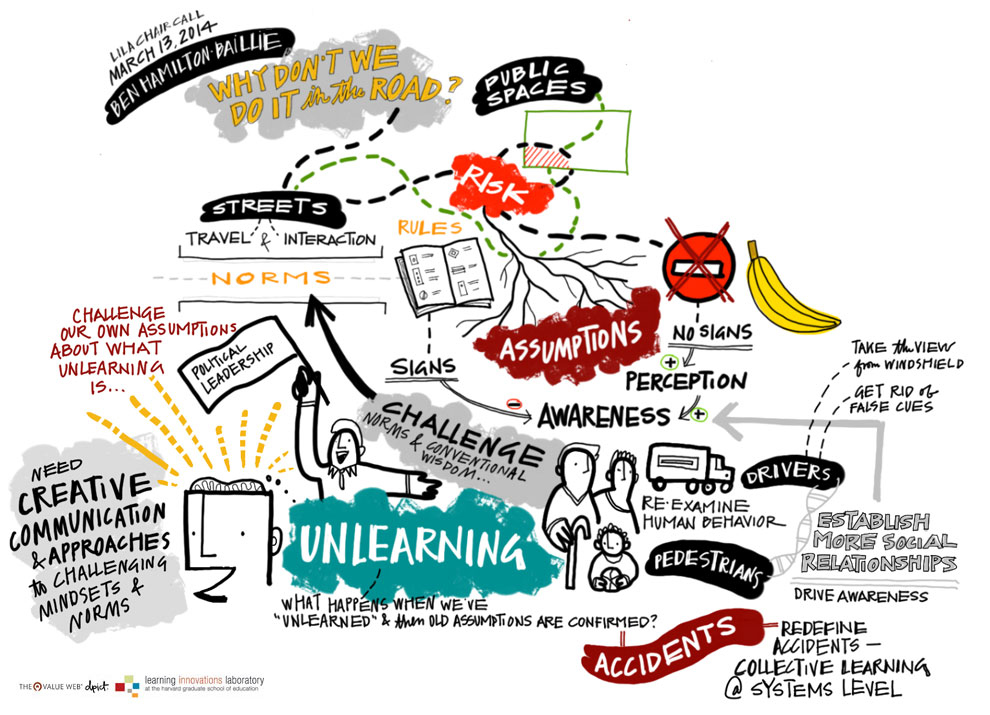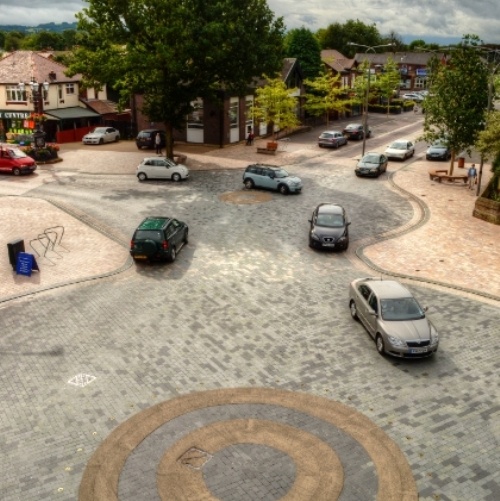 During the February gathering we deepened our understanding of the dynamics of habits, investigating why unlearning can sometimes be challenging and what we can do to foster it. The March Chair Call was a bridge between our exploration of how to change individual mindsets and habits to unlearning at a systems level. As a way to spark our thinking about what drives systemic change, we invited architect Ben Hamilton-Baillie to join and share the ideas behind Shared Space, an urban design approach which seeks to minimize demarcations between vehicle traffic and pedestrians, often by removing features such as curbs, road markings, traffic signs and some regulations. This approach goes contrary to how many towns, states and countries have chosen to shape driver’s behavior – that is through legislation. To the surprise of many skeptics, this Shared Space approach works. Ben explained that although streets are familiar to everyone, they have become complicated places that serve multiple uses. On the one hand, streets facilitate movement – traffic flow and on the other hand they facilitate interaction – in other words, trade and meeting places serving a social function. These two purposes have evolved over the years but the thinking about what constitutes streets and thriving town centers hasn’t changed quickly enough. We have grown up thinking that streets should have lines down the middle, a parking curb, a designated crossing area and barriers that separate pedestrians from motorists.
During the February gathering we deepened our understanding of the dynamics of habits, investigating why unlearning can sometimes be challenging and what we can do to foster it. The March Chair Call was a bridge between our exploration of how to change individual mindsets and habits to unlearning at a systems level. As a way to spark our thinking about what drives systemic change, we invited architect Ben Hamilton-Baillie to join and share the ideas behind Shared Space, an urban design approach which seeks to minimize demarcations between vehicle traffic and pedestrians, often by removing features such as curbs, road markings, traffic signs and some regulations. This approach goes contrary to how many towns, states and countries have chosen to shape driver’s behavior – that is through legislation. To the surprise of many skeptics, this Shared Space approach works. Ben explained that although streets are familiar to everyone, they have become complicated places that serve multiple uses. On the one hand, streets facilitate movement – traffic flow and on the other hand they facilitate interaction – in other words, trade and meeting places serving a social function. These two purposes have evolved over the years but the thinking about what constitutes streets and thriving town centers hasn’t changed quickly enough. We have grown up thinking that streets should have lines down the middle, a parking curb, a designated crossing area and barriers that separate pedestrians from motorists.
Changing Mindsets
- To solve traffic congestion problems and the lack of public spaces required a mindset shift. Thinking of streets as part of the public space with unregulated, unpredictable and constantly changing characteristics rather than segregated from other aspects of life required letting go of past assumptions.
- The approach is maybe best captured by a quote from Hans Monderman, a traffic engineer who was head of road safety for the provinces in northern Netherlands who said, “ A safe street is one that tells stories about its past, its context and the future hopes of its residents.”
- They needed to unlearn the way they had defined safety and reconsider the value and importance of risk in designing public space.
Marga: How is risk defined in our organizations? What might we need to unlearn? How we can create cultures in which individuals are able to innovate, what are the barriers organizations put in place that limit the degree of experimentation? How can we design safe environments in which individuals can experiment, learn and unlearn naturally?
Changing Habits
- Removing barriers between pedestrians and drivers doesn’t necessarily increase accidents. Rather, if you provide visual cues to drivers that something is different, narrow the streets and limit signage drivers develop common sense awareness and use emerging social protocols.
Marga: How many rules and procedures in our organizations are no longer helpful? What are the triggers, cues and “road” signs that would help individuals recognize habits that need to be changed. How can we cue up helpful habits? What systemic mindsets and habits have to be unlearned before change can be initiated? How might we create unlearning opportunities by introducing “oddball / tangential cues that trigger intentional rather than habitual responses?
Changing Systems
 Removing walls between schools and streets and extending the playground across the street so that when cars drove through the town they passed through the playground affected the driver’s perceptions of wha is a street. It made drivers aware of the activities of the school.
Removing walls between schools and streets and extending the playground across the street so that when cars drove through the town they passed through the playground affected the driver’s perceptions of wha is a street. It made drivers aware of the activities of the school.
- Poynton in Chesire, a cross-roads town where 26,000 cars passed through each day with an town center that was dying. The town center was remodeled as a place rather than a traffic center, using informal crossings and round offs. They narrowed the entrances, reduced traffic lanes and driving space available. The effect was to slow down traffic as it approached the town center that was transformed and people’s perception of right to drive fast changed.
- This redesign challenges the conventional wisdom and necessitated a lot of unlearning by engineers, traffic professionals, businesses and residents who held long-held assumptions about what made for safety could be done without adverse effect.
- Understanding human behavior is central to this approach – allowing drivers to think and be part of the dynamic of a small town produces safe driving. Safety is about having humans think for themselves. The idea is to bring back the decision-making to the individual, or community level rather than state level.
Marga: In our own organizations, we often try to improve performance by clearly defining work processes and procedures expecting that these will produce the expected outcomes. Yet in many cases they don’t. How does this approach run counter to traditional ways we think about motivation and change? How do you design systemic cues into the environment in order to prompt different actions and sustain the new behaviors ? How might we help individuals internalize the need for unlearning rather than regulating behavior through pre-defined processes and procedures in organizations? How might we rethink the traditional way we organize work by functions and go for a more integrated approach?
To listen to the WebEx of this Chair Call go to: https://www.learninginnovationslab.org/wp-content/uploads/_mediavault/2014/03/March-Chair-Call.m4v
